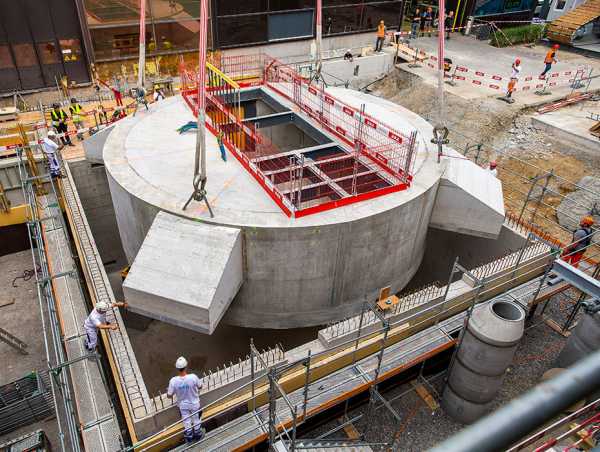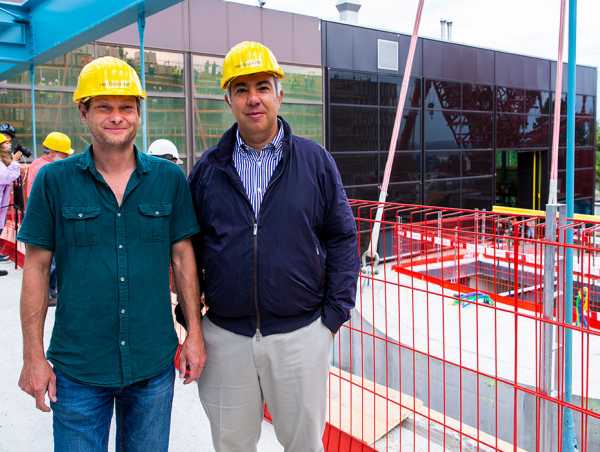A spectacular initiative
A 245-tonne circular concrete chamber has been installed at the Hönggerberg campus. It serves as the housing of a large geotechnical centrifuge that is used to model earthquakes and their effects on soils and buildings.

From afar, it looked like a UFO hovering over the Hönggerberg campus. That’s how massive the circular concrete chamber looked with its four “teeth”. It hung about 25 metres above the ground, suspended by an equally massive special crane. The crane was required to lift the circular platform and lower it onto the designated location – after all, at ten metres in diameter and three metres in height, it weighs a staggering 245 tonnes. To assemble the crane alone, about 30 lorry deliveries have been necessary since Monday to bring all the parts onto the campus. The platform itself was cast from reinforced concrete at the HIF building site during recent months.
Centrifuge simulates earthquakes
As it turned out, it took just under an hour to lower the circular chamber into the ground on Friday morning. It is now underground in the inner courtyard, which spans between the test hall and the new extension wing of the HIF building. The HIF building, which was erected in 1976 and is currently undergoing renovations and an extension, houses the professorships of the Department of Civil, Environmental and Geomatic Engineering (D-BAUG).
“I’m thrilled,” said Ioannis Anastasopoulos, Professor of Geotechnical Engineering, as he witnessed the installation of the chamber, which has been installed at his request. The chamber itself is merely the first step on the way to a new research infrastructure for geotechnical engineering: the next step will involve installing a geotechnical beam centrifuge into the chamber. This centrifuge will allow the ETH researchers to simulate earthquakes, ground movements, such as landslides, and hydrodynamic processes, such as tsunami waves and scouring.
One of the largest centrifuges in the world
These realistic models enable conclusions to be drawn about the stability of critical infrastructure and the potential risk of ground movement due to earthquakes, landslides, tsunamis or scouring. The new centrifuge will contribute to the simulation of various problems that are of great relevance to the needs of the construction industry, such as the foundations of bridges and high-rise buildings, dams, landslides, and tunnels.
The new research infrastructure represents a significant advancement in realistically simulating such complicated processes, allowing for design optimization and risk reduction. In Europe, there are few others of a comparable size – in the UK, France, and the Netherlands. With a diameter of 9 metres and a capacity of 500 gtons, the geotechnical centrifuge will even be one of the largest in the world. The figure of “500 gtons” refers to the fact that the centrifuge can carry 2 tons at an increased gravitational field of 250 g (g = earth's gravity). And, 2 tons multiplied by 250 gravities results in 500 gtons. This is how the centrifuge capacity is measured.
Concrete chamber absorbs vibrations
The circular reinforced concrete chamber serves as the foundation of the centrifuge and rests on the specially designed steel springs. This special design absorbs the vibrations generated by the centrifuge and prevents them from penetrating the soil and spreading beneath the campus, thus ensuring that high-accuracy measurements taken in laboratories inside other campus buildings won’t be disturbed. “This the first vibration isolated geotechnical centrifuge in the world,” says Ioannis Anastasopoulos.
The centrifuge is not brand new, but rather an example of how existing equipment can be reused for research. Decommissioned in Germany, it is now being fully refurbished in terms of hydraulics, electronics and control systems. In October, it will be coming to the Hönggerberg campus. A state-of-the-art centrifuge-mounted shaker will be added to allow reproduction of real earthquakes.
The new centrifuge will be part of a new Centre of Excellence in Centrifuge Modelling at the Institute for Geotechnical Engineering, which will further strengthen ETH Zurich's leading position in this research area and substantially broaden the Institute's innovation potential. It is a key component of this centre of excellence, which will include other soil testing facilities. Considering the combined capabilities, the new ETH Centre of Excellence will be unique at a worldwide level. With respect to seismic shaking for example, there are only three centrifuge facilities in Europe capable of such testing.
Impressions




Comments
No comments yet